Social Media's Role and Influence in Travel and Tourism Choices
VerifiedAdded on 2023/02/13
|12
|1794
|47
Presentation
AI Summary
This presentation examines the significant role of social media in influencing travel and tourism customer behavior. It explores the impact of online communication, Web 2.0, and social media platforms on consumer purchase decisions, focusing specifically on the travel and tourism sector. The presentation outlines the study's aim to analyze this influence, including a literature review of existing models, demonstrating causality between social media engagement and purchase decisions, and proposing a conceptual framework for the tourism sector. The research questions address the extent of social media's influence on tourists, its evolution over time, and consumer trust in online content. The methodology involves an interpretivist framework, qualitative approach using focus groups to gather diverse perspectives, and thematic analysis for data interpretation. The presentation also includes a detailed time frame, literature review, methodology, data analysis plan, and references.
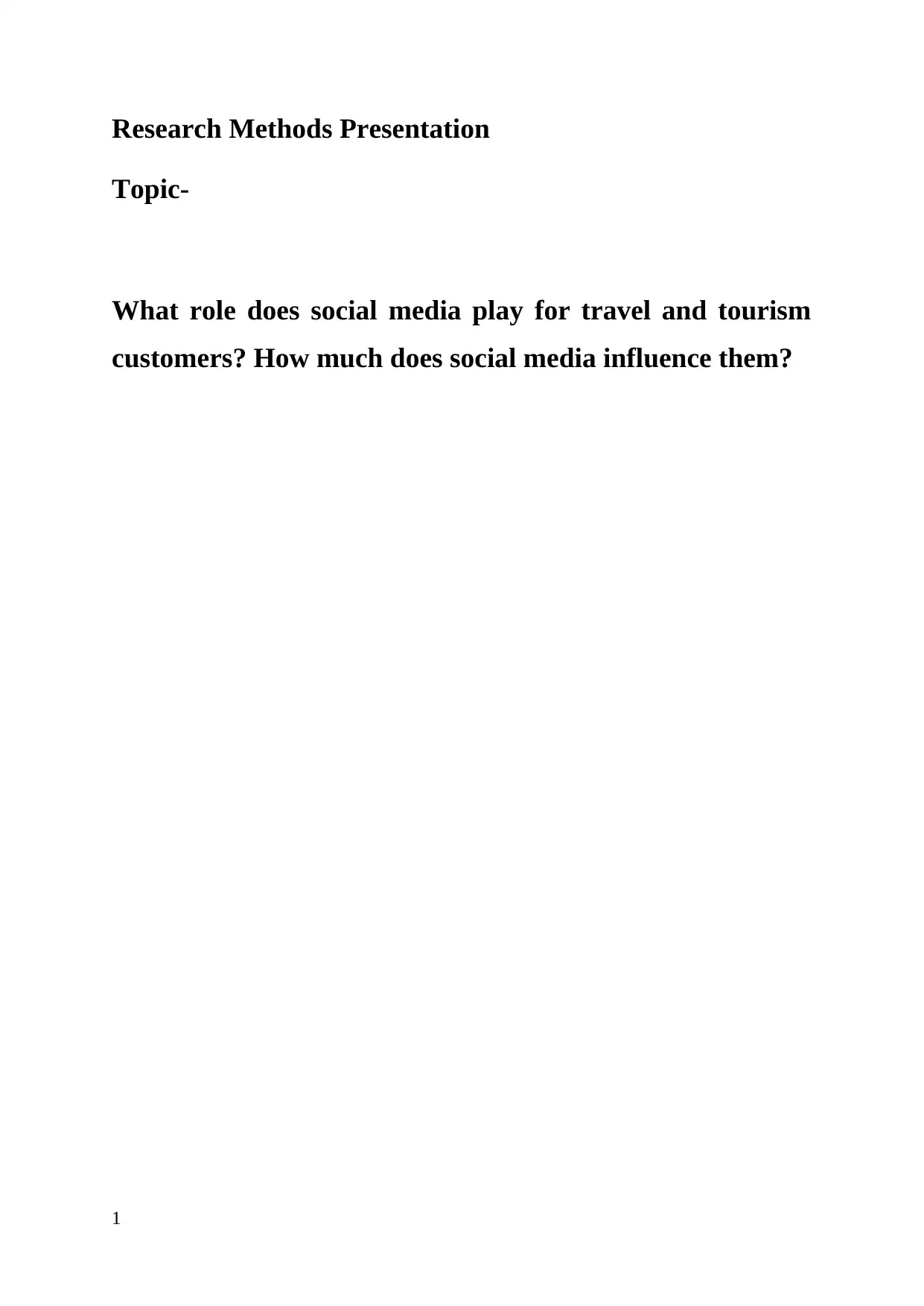
Research Methods Presentation
Topic-
What role does social media play for travel and tourism
customers? How much does social media influence them?
1
Topic-
What role does social media play for travel and tourism
customers? How much does social media influence them?
1
Paraphrase This Document
Need a fresh take? Get an instant paraphrase of this document with our AI Paraphraser
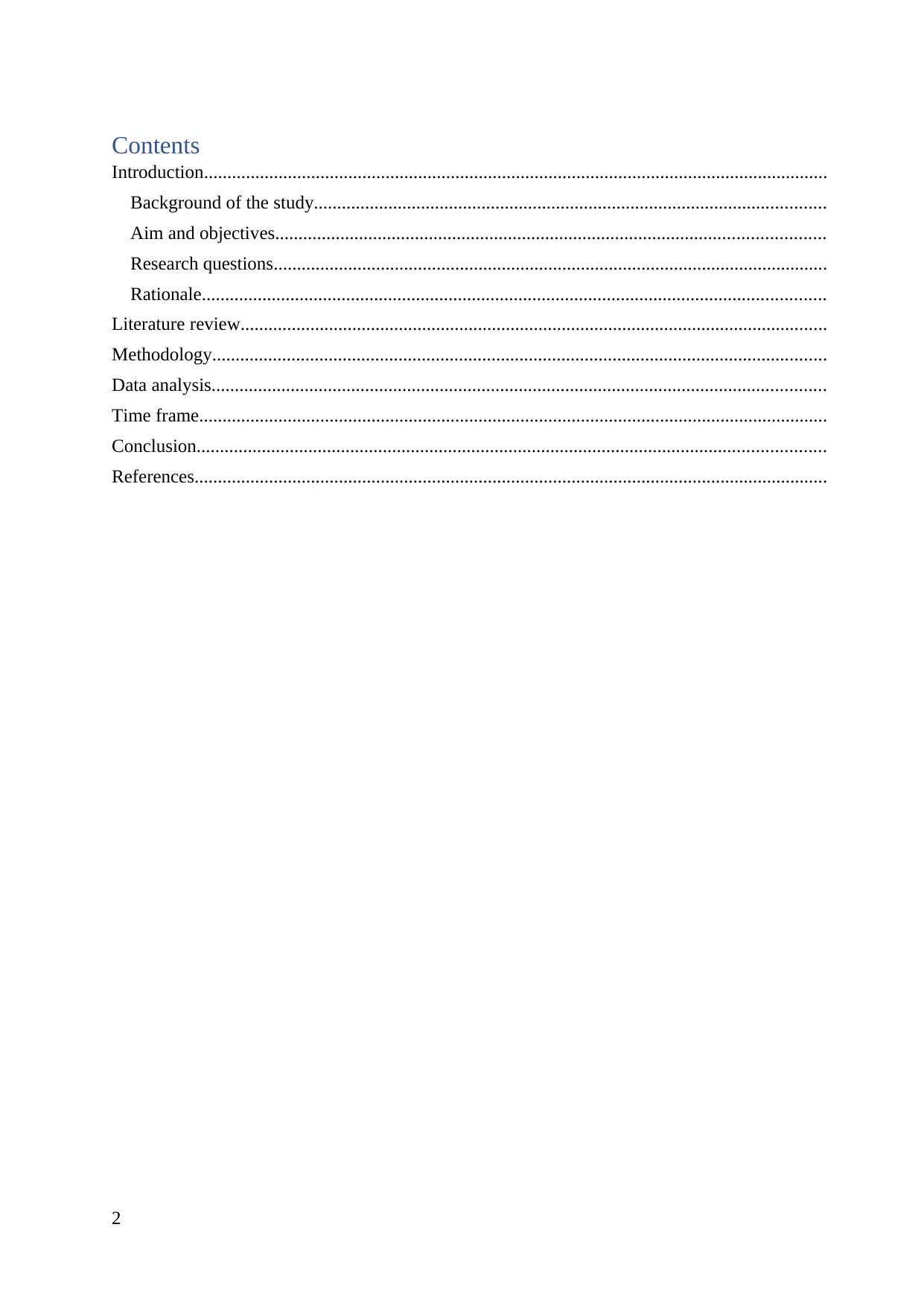
Contents
Introduction......................................................................................................................................
Background of the study..............................................................................................................
Aim and objectives......................................................................................................................
Research questions.......................................................................................................................
Rationale......................................................................................................................................
Literature review..............................................................................................................................
Methodology....................................................................................................................................
Data analysis....................................................................................................................................
Time frame.......................................................................................................................................
Conclusion.......................................................................................................................................
References........................................................................................................................................
2
Introduction......................................................................................................................................
Background of the study..............................................................................................................
Aim and objectives......................................................................................................................
Research questions.......................................................................................................................
Rationale......................................................................................................................................
Literature review..............................................................................................................................
Methodology....................................................................................................................................
Data analysis....................................................................................................................................
Time frame.......................................................................................................................................
Conclusion.......................................................................................................................................
References........................................................................................................................................
2
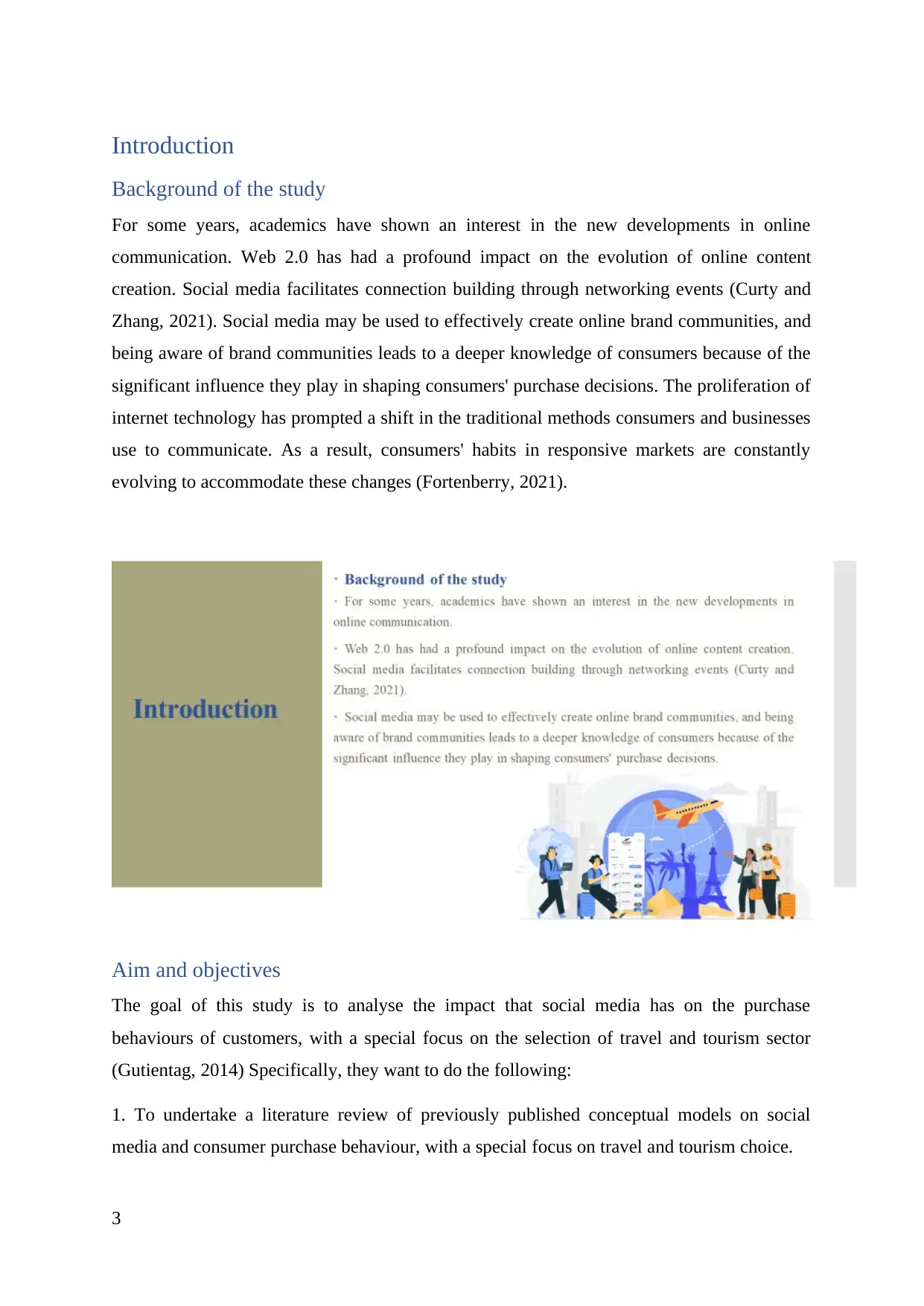
Introduction
Background of the study
For some years, academics have shown an interest in the new developments in online
communication. Web 2.0 has had a profound impact on the evolution of online content
creation. Social media facilitates connection building through networking events (Curty and
Zhang, 2021). Social media may be used to effectively create online brand communities, and
being aware of brand communities leads to a deeper knowledge of consumers because of the
significant influence they play in shaping consumers' purchase decisions. The proliferation of
internet technology has prompted a shift in the traditional methods consumers and businesses
use to communicate. As a result, consumers' habits in responsive markets are constantly
evolving to accommodate these changes (Fortenberry, 2021).
Aim and objectives
The goal of this study is to analyse the impact that social media has on the purchase
behaviours of customers, with a special focus on the selection of travel and tourism sector
(Gutientag, 2014) Specifically, they want to do the following:
1. To undertake a literature review of previously published conceptual models on social
media and consumer purchase behaviour, with a special focus on travel and tourism choice.
3
Background of the study
For some years, academics have shown an interest in the new developments in online
communication. Web 2.0 has had a profound impact on the evolution of online content
creation. Social media facilitates connection building through networking events (Curty and
Zhang, 2021). Social media may be used to effectively create online brand communities, and
being aware of brand communities leads to a deeper knowledge of consumers because of the
significant influence they play in shaping consumers' purchase decisions. The proliferation of
internet technology has prompted a shift in the traditional methods consumers and businesses
use to communicate. As a result, consumers' habits in responsive markets are constantly
evolving to accommodate these changes (Fortenberry, 2021).
Aim and objectives
The goal of this study is to analyse the impact that social media has on the purchase
behaviours of customers, with a special focus on the selection of travel and tourism sector
(Gutientag, 2014) Specifically, they want to do the following:
1. To undertake a literature review of previously published conceptual models on social
media and consumer purchase behaviour, with a special focus on travel and tourism choice.
3
⊘ This is a preview!⊘
Do you want full access?
Subscribe today to unlock all pages.

Trusted by 1+ million students worldwide
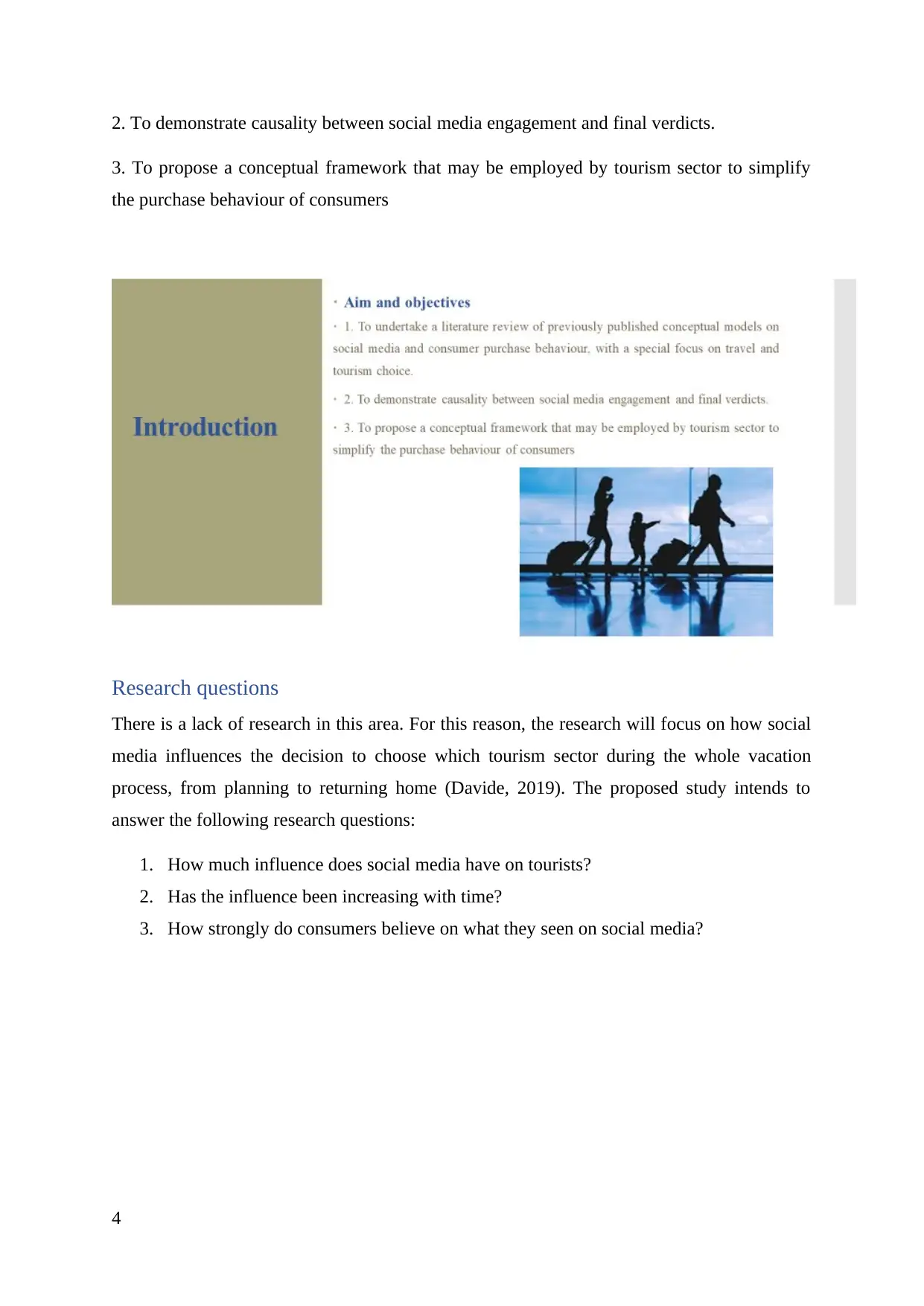
2. To demonstrate causality between social media engagement and final verdicts.
3. To propose a conceptual framework that may be employed by tourism sector to simplify
the purchase behaviour of consumers
Research questions
There is a lack of research in this area. For this reason, the research will focus on how social
media influences the decision to choose which tourism sector during the whole vacation
process, from planning to returning home (Davide, 2019). The proposed study intends to
answer the following research questions:
1. How much influence does social media have on tourists?
2. Has the influence been increasing with time?
3. How strongly do consumers believe on what they seen on social media?
4
3. To propose a conceptual framework that may be employed by tourism sector to simplify
the purchase behaviour of consumers
Research questions
There is a lack of research in this area. For this reason, the research will focus on how social
media influences the decision to choose which tourism sector during the whole vacation
process, from planning to returning home (Davide, 2019). The proposed study intends to
answer the following research questions:
1. How much influence does social media have on tourists?
2. Has the influence been increasing with time?
3. How strongly do consumers believe on what they seen on social media?
4
Paraphrase This Document
Need a fresh take? Get an instant paraphrase of this document with our AI Paraphraser
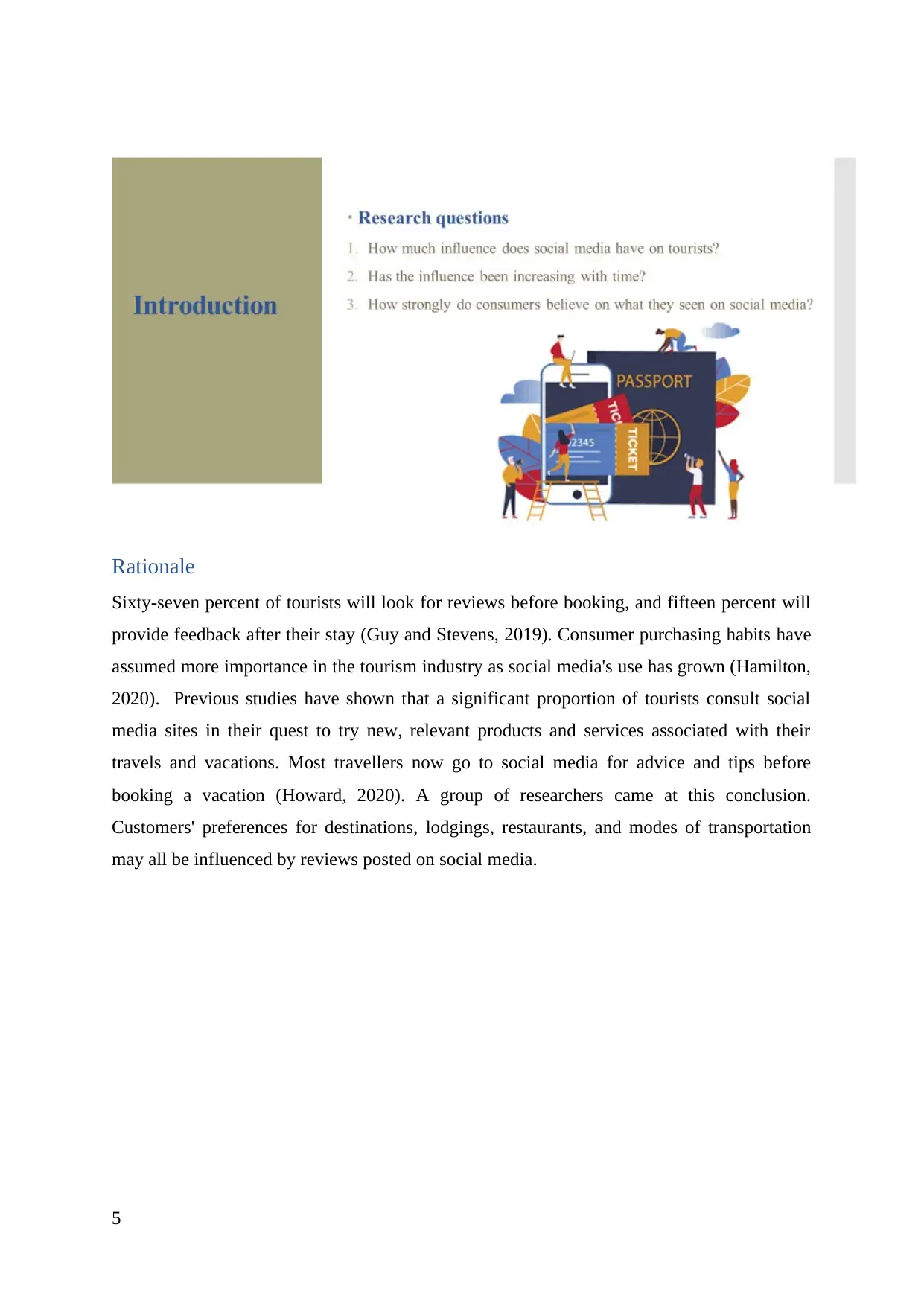
Rationale
Sixty-seven percent of tourists will look for reviews before booking, and fifteen percent will
provide feedback after their stay (Guy and Stevens, 2019). Consumer purchasing habits have
assumed more importance in the tourism industry as social media's use has grown (Hamilton,
2020). Previous studies have shown that a significant proportion of tourists consult social
media sites in their quest to try new, relevant products and services associated with their
travels and vacations. Most travellers now go to social media for advice and tips before
booking a vacation (Howard, 2020). A group of researchers came at this conclusion.
Customers' preferences for destinations, lodgings, restaurants, and modes of transportation
may all be influenced by reviews posted on social media.
5
Sixty-seven percent of tourists will look for reviews before booking, and fifteen percent will
provide feedback after their stay (Guy and Stevens, 2019). Consumer purchasing habits have
assumed more importance in the tourism industry as social media's use has grown (Hamilton,
2020). Previous studies have shown that a significant proportion of tourists consult social
media sites in their quest to try new, relevant products and services associated with their
travels and vacations. Most travellers now go to social media for advice and tips before
booking a vacation (Howard, 2020). A group of researchers came at this conclusion.
Customers' preferences for destinations, lodgings, restaurants, and modes of transportation
may all be influenced by reviews posted on social media.
5
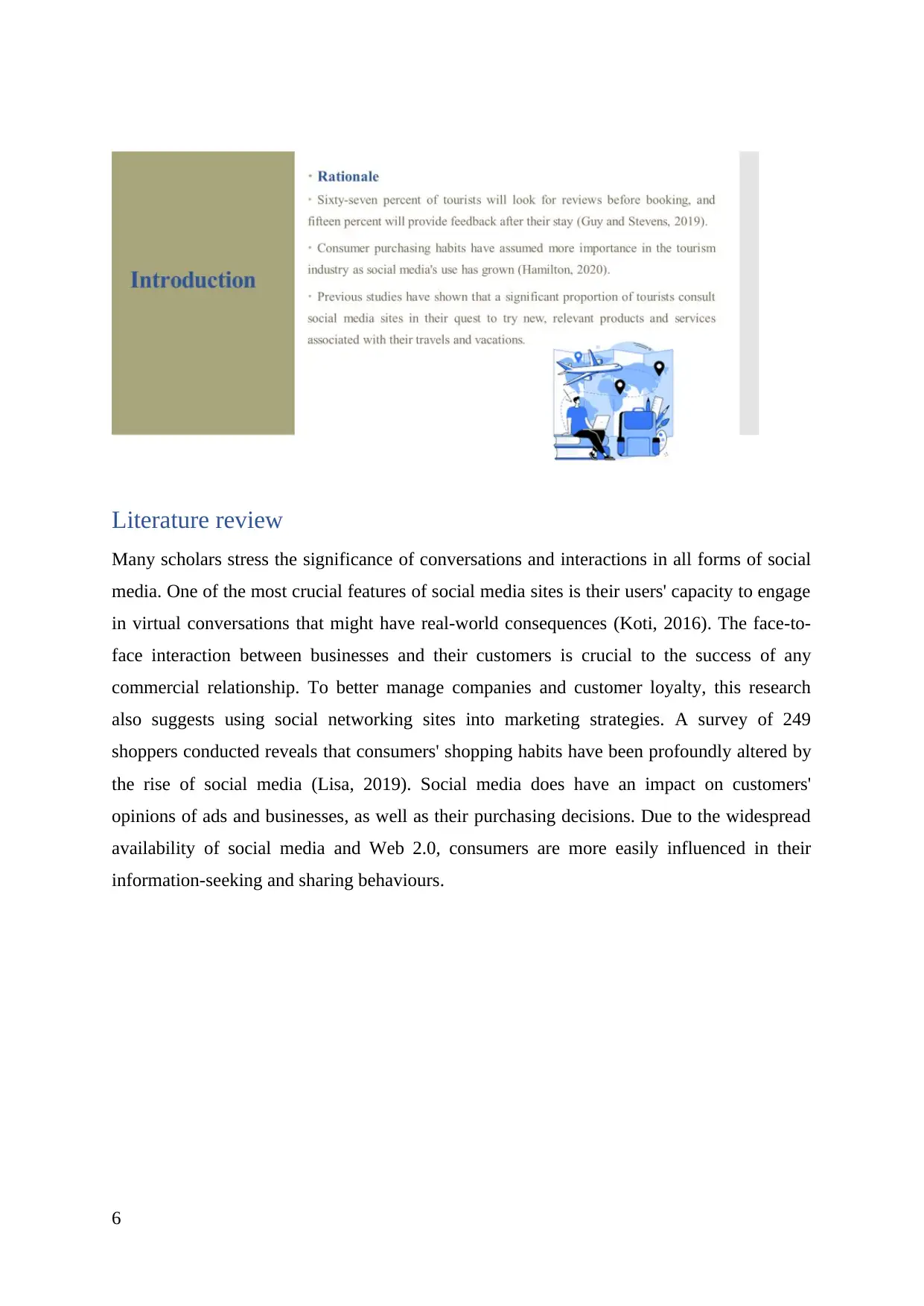
Literature review
Many scholars stress the significance of conversations and interactions in all forms of social
media. One of the most crucial features of social media sites is their users' capacity to engage
in virtual conversations that might have real-world consequences (Koti, 2016). The face-to-
face interaction between businesses and their customers is crucial to the success of any
commercial relationship. To better manage companies and customer loyalty, this research
also suggests using social networking sites into marketing strategies. A survey of 249
shoppers conducted reveals that consumers' shopping habits have been profoundly altered by
the rise of social media (Lisa, 2019). Social media does have an impact on customers'
opinions of ads and businesses, as well as their purchasing decisions. Due to the widespread
availability of social media and Web 2.0, consumers are more easily influenced in their
information-seeking and sharing behaviours.
6
Many scholars stress the significance of conversations and interactions in all forms of social
media. One of the most crucial features of social media sites is their users' capacity to engage
in virtual conversations that might have real-world consequences (Koti, 2016). The face-to-
face interaction between businesses and their customers is crucial to the success of any
commercial relationship. To better manage companies and customer loyalty, this research
also suggests using social networking sites into marketing strategies. A survey of 249
shoppers conducted reveals that consumers' shopping habits have been profoundly altered by
the rise of social media (Lisa, 2019). Social media does have an impact on customers'
opinions of ads and businesses, as well as their purchasing decisions. Due to the widespread
availability of social media and Web 2.0, consumers are more easily influenced in their
information-seeking and sharing behaviours.
6
⊘ This is a preview!⊘
Do you want full access?
Subscribe today to unlock all pages.

Trusted by 1+ million students worldwide
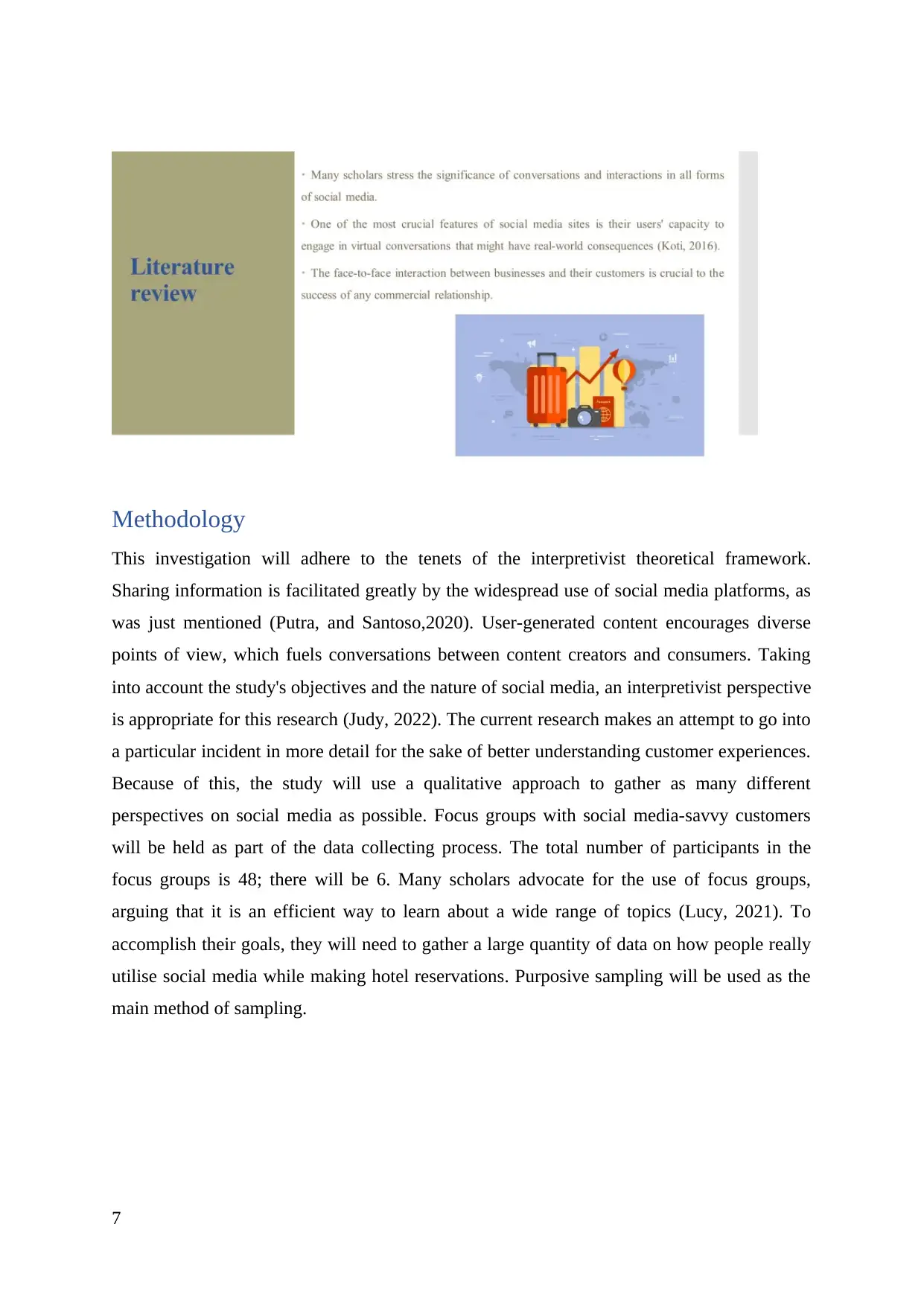
Methodology
This investigation will adhere to the tenets of the interpretivist theoretical framework.
Sharing information is facilitated greatly by the widespread use of social media platforms, as
was just mentioned (Putra, and Santoso,2020). User-generated content encourages diverse
points of view, which fuels conversations between content creators and consumers. Taking
into account the study's objectives and the nature of social media, an interpretivist perspective
is appropriate for this research (Judy, 2022). The current research makes an attempt to go into
a particular incident in more detail for the sake of better understanding customer experiences.
Because of this, the study will use a qualitative approach to gather as many different
perspectives on social media as possible. Focus groups with social media-savvy customers
will be held as part of the data collecting process. The total number of participants in the
focus groups is 48; there will be 6. Many scholars advocate for the use of focus groups,
arguing that it is an efficient way to learn about a wide range of topics (Lucy, 2021). To
accomplish their goals, they will need to gather a large quantity of data on how people really
utilise social media while making hotel reservations. Purposive sampling will be used as the
main method of sampling.
7
This investigation will adhere to the tenets of the interpretivist theoretical framework.
Sharing information is facilitated greatly by the widespread use of social media platforms, as
was just mentioned (Putra, and Santoso,2020). User-generated content encourages diverse
points of view, which fuels conversations between content creators and consumers. Taking
into account the study's objectives and the nature of social media, an interpretivist perspective
is appropriate for this research (Judy, 2022). The current research makes an attempt to go into
a particular incident in more detail for the sake of better understanding customer experiences.
Because of this, the study will use a qualitative approach to gather as many different
perspectives on social media as possible. Focus groups with social media-savvy customers
will be held as part of the data collecting process. The total number of participants in the
focus groups is 48; there will be 6. Many scholars advocate for the use of focus groups,
arguing that it is an efficient way to learn about a wide range of topics (Lucy, 2021). To
accomplish their goals, they will need to gather a large quantity of data on how people really
utilise social media while making hotel reservations. Purposive sampling will be used as the
main method of sampling.
7
Paraphrase This Document
Need a fresh take? Get an instant paraphrase of this document with our AI Paraphraser
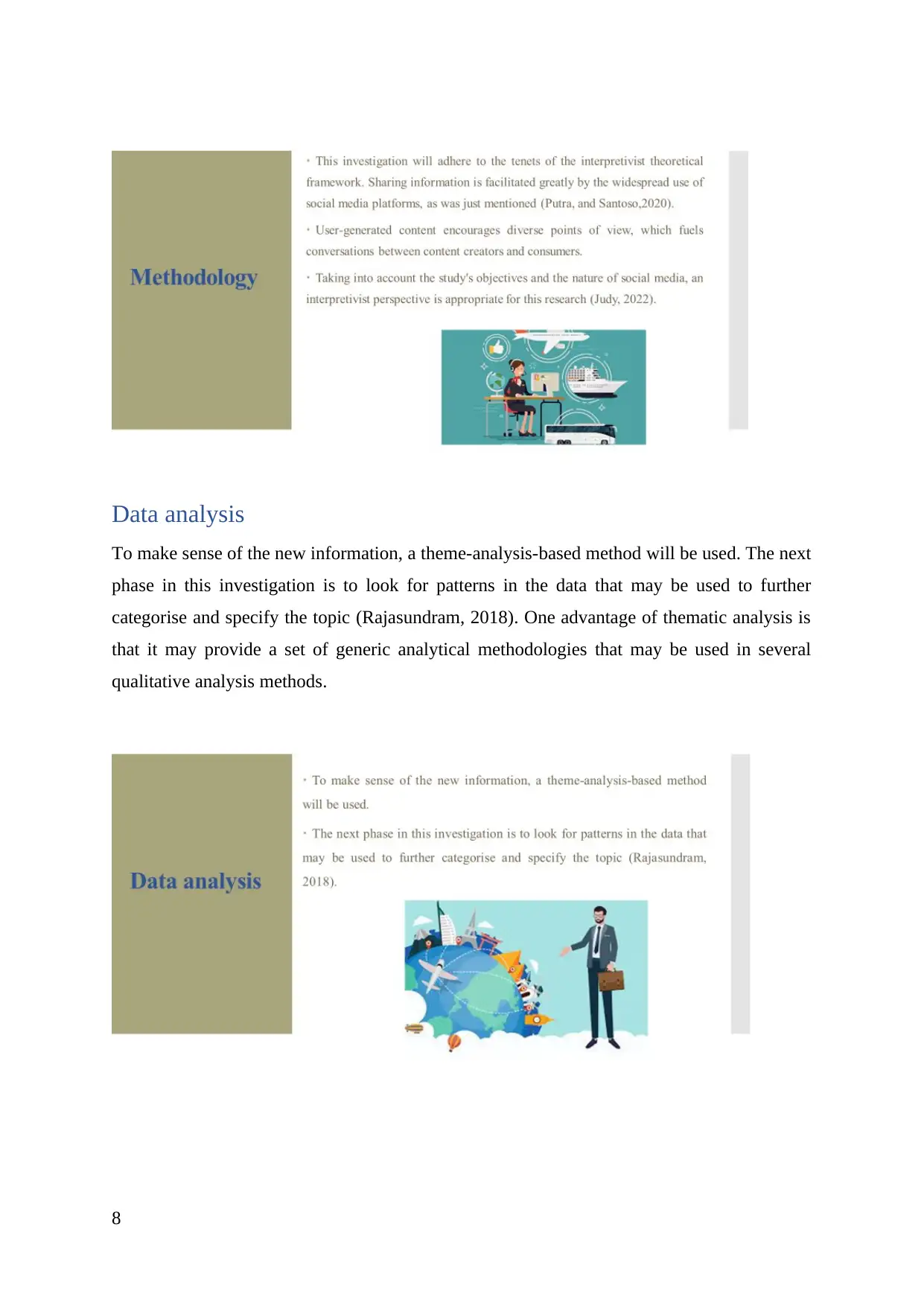
Data analysis
To make sense of the new information, a theme-analysis-based method will be used. The next
phase in this investigation is to look for patterns in the data that may be used to further
categorise and specify the topic (Rajasundram, 2018). One advantage of thematic analysis is
that it may provide a set of generic analytical methodologies that may be used in several
qualitative analysis methods.
8
To make sense of the new information, a theme-analysis-based method will be used. The next
phase in this investigation is to look for patterns in the data that may be used to further
categorise and specify the topic (Rajasundram, 2018). One advantage of thematic analysis is
that it may provide a set of generic analytical methodologies that may be used in several
qualitative analysis methods.
8
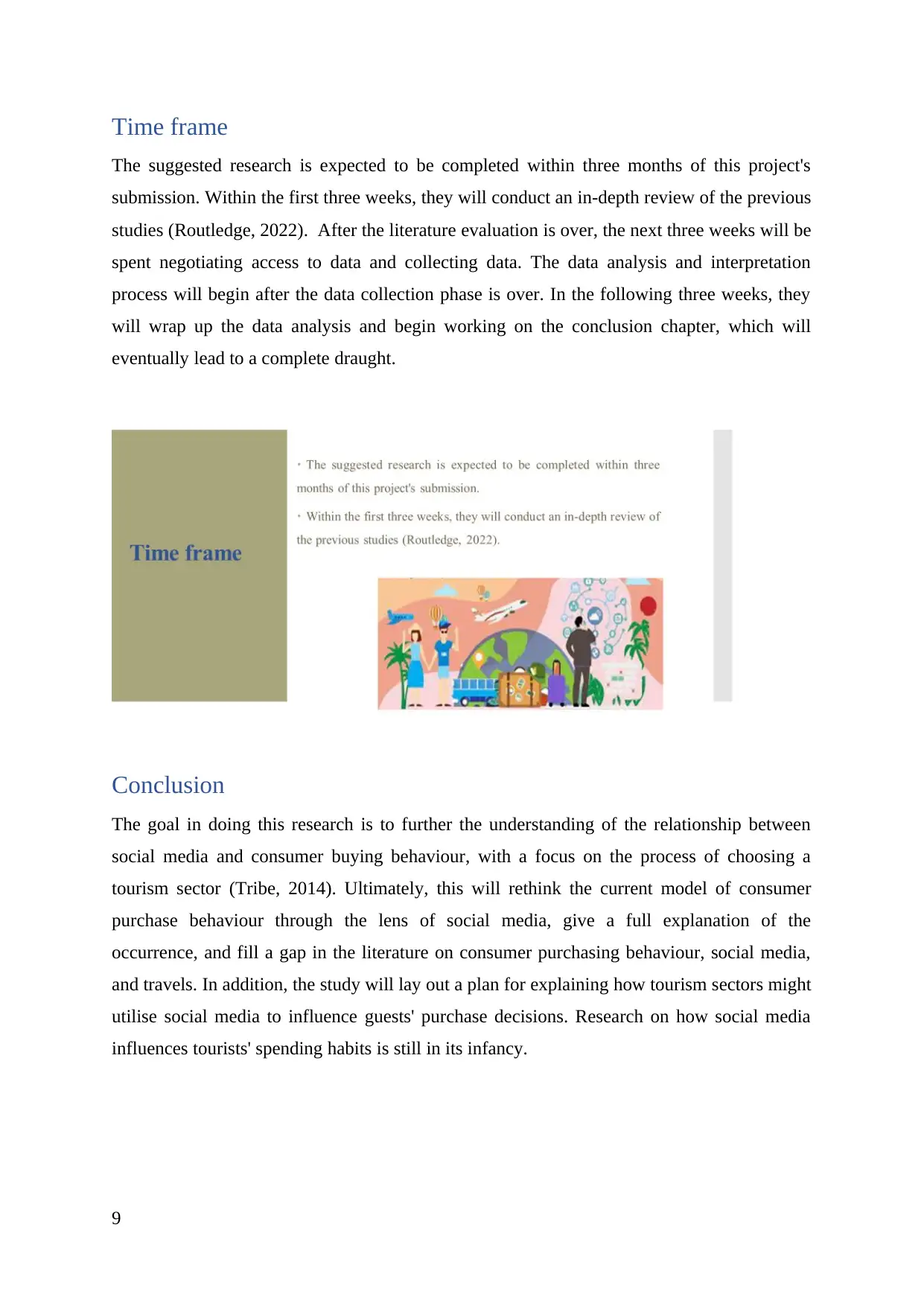
Time frame
The suggested research is expected to be completed within three months of this project's
submission. Within the first three weeks, they will conduct an in-depth review of the previous
studies (Routledge, 2022). After the literature evaluation is over, the next three weeks will be
spent negotiating access to data and collecting data. The data analysis and interpretation
process will begin after the data collection phase is over. In the following three weeks, they
will wrap up the data analysis and begin working on the conclusion chapter, which will
eventually lead to a complete draught.
Conclusion
The goal in doing this research is to further the understanding of the relationship between
social media and consumer buying behaviour, with a focus on the process of choosing a
tourism sector (Tribe, 2014). Ultimately, this will rethink the current model of consumer
purchase behaviour through the lens of social media, give a full explanation of the
occurrence, and fill a gap in the literature on consumer purchasing behaviour, social media,
and travels. In addition, the study will lay out a plan for explaining how tourism sectors might
utilise social media to influence guests' purchase decisions. Research on how social media
influences tourists' spending habits is still in its infancy.
9
The suggested research is expected to be completed within three months of this project's
submission. Within the first three weeks, they will conduct an in-depth review of the previous
studies (Routledge, 2022). After the literature evaluation is over, the next three weeks will be
spent negotiating access to data and collecting data. The data analysis and interpretation
process will begin after the data collection phase is over. In the following three weeks, they
will wrap up the data analysis and begin working on the conclusion chapter, which will
eventually lead to a complete draught.
Conclusion
The goal in doing this research is to further the understanding of the relationship between
social media and consumer buying behaviour, with a focus on the process of choosing a
tourism sector (Tribe, 2014). Ultimately, this will rethink the current model of consumer
purchase behaviour through the lens of social media, give a full explanation of the
occurrence, and fill a gap in the literature on consumer purchasing behaviour, social media,
and travels. In addition, the study will lay out a plan for explaining how tourism sectors might
utilise social media to influence guests' purchase decisions. Research on how social media
influences tourists' spending habits is still in its infancy.
9
⊘ This is a preview!⊘
Do you want full access?
Subscribe today to unlock all pages.

Trusted by 1+ million students worldwide
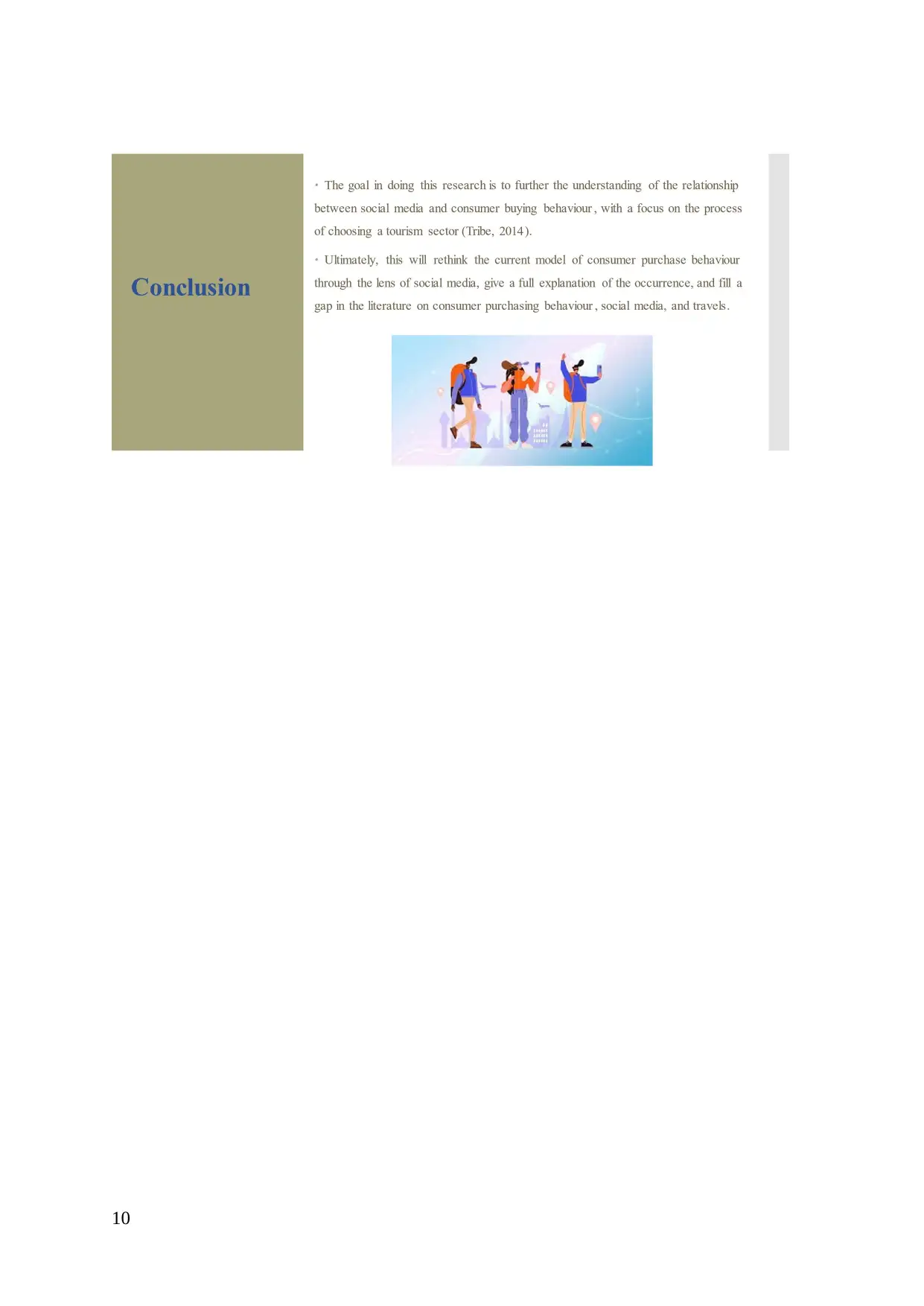
10
Paraphrase This Document
Need a fresh take? Get an instant paraphrase of this document with our AI Paraphraser
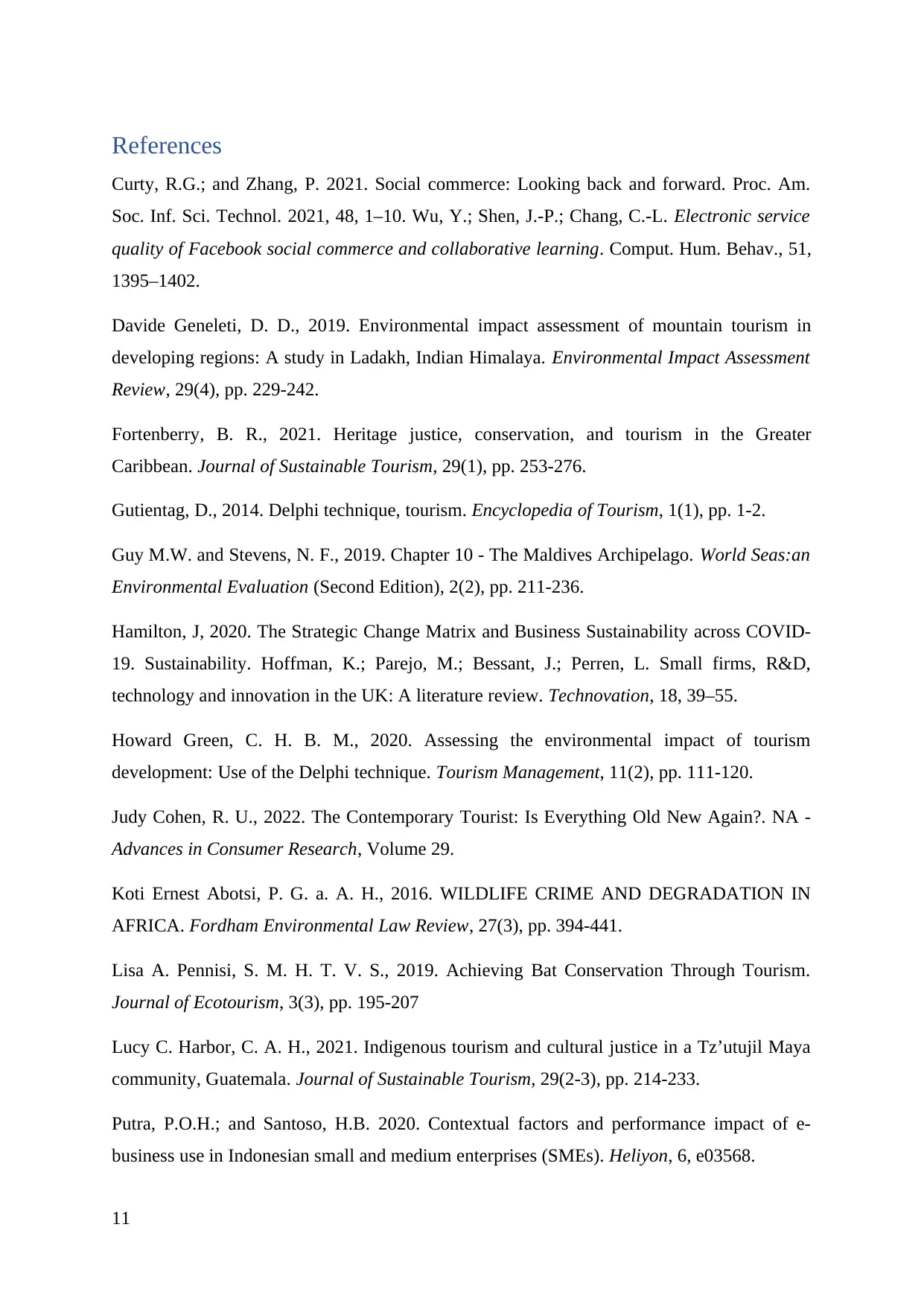
References
Curty, R.G.; and Zhang, P. 2021. Social commerce: Looking back and forward. Proc. Am.
Soc. Inf. Sci. Technol. 2021, 48, 1–10. Wu, Y.; Shen, J.-P.; Chang, C.-L. Electronic service
quality of Facebook social commerce and collaborative learning. Comput. Hum. Behav., 51,
1395–1402.
Davide Geneleti, D. D., 2019. Environmental impact assessment of mountain tourism in
developing regions: A study in Ladakh, Indian Himalaya. Environmental Impact Assessment
Review, 29(4), pp. 229-242.
Fortenberry, B. R., 2021. Heritage justice, conservation, and tourism in the Greater
Caribbean. Journal of Sustainable Tourism, 29(1), pp. 253-276.
Gutientag, D., 2014. Delphi technique, tourism. Encyclopedia of Tourism, 1(1), pp. 1-2.
Guy M.W. and Stevens, N. F., 2019. Chapter 10 - The Maldives Archipelago. World Seas:an
Environmental Evaluation (Second Edition), 2(2), pp. 211-236.
Hamilton, J, 2020. The Strategic Change Matrix and Business Sustainability across COVID-
19. Sustainability. Hoffman, K.; Parejo, M.; Bessant, J.; Perren, L. Small firms, R&D,
technology and innovation in the UK: A literature review. Technovation, 18, 39–55.
Howard Green, C. H. B. M., 2020. Assessing the environmental impact of tourism
development: Use of the Delphi technique. Tourism Management, 11(2), pp. 111-120.
Judy Cohen, R. U., 2022. The Contemporary Tourist: Is Everything Old New Again?. NA -
Advances in Consumer Research, Volume 29.
Koti Ernest Abotsi, P. G. a. A. H., 2016. WILDLIFE CRIME AND DEGRADATION IN
AFRICA. Fordham Environmental Law Review, 27(3), pp. 394-441.
Lisa A. Pennisi, S. M. H. T. V. S., 2019. Achieving Bat Conservation Through Tourism.
Journal of Ecotourism, 3(3), pp. 195-207
Lucy C. Harbor, C. A. H., 2021. Indigenous tourism and cultural justice in a Tz’utujil Maya
community, Guatemala. Journal of Sustainable Tourism, 29(2-3), pp. 214-233.
Putra, P.O.H.; and Santoso, H.B. 2020. Contextual factors and performance impact of e-
business use in Indonesian small and medium enterprises (SMEs). Heliyon, 6, e03568.
11
Curty, R.G.; and Zhang, P. 2021. Social commerce: Looking back and forward. Proc. Am.
Soc. Inf. Sci. Technol. 2021, 48, 1–10. Wu, Y.; Shen, J.-P.; Chang, C.-L. Electronic service
quality of Facebook social commerce and collaborative learning. Comput. Hum. Behav., 51,
1395–1402.
Davide Geneleti, D. D., 2019. Environmental impact assessment of mountain tourism in
developing regions: A study in Ladakh, Indian Himalaya. Environmental Impact Assessment
Review, 29(4), pp. 229-242.
Fortenberry, B. R., 2021. Heritage justice, conservation, and tourism in the Greater
Caribbean. Journal of Sustainable Tourism, 29(1), pp. 253-276.
Gutientag, D., 2014. Delphi technique, tourism. Encyclopedia of Tourism, 1(1), pp. 1-2.
Guy M.W. and Stevens, N. F., 2019. Chapter 10 - The Maldives Archipelago. World Seas:an
Environmental Evaluation (Second Edition), 2(2), pp. 211-236.
Hamilton, J, 2020. The Strategic Change Matrix and Business Sustainability across COVID-
19. Sustainability. Hoffman, K.; Parejo, M.; Bessant, J.; Perren, L. Small firms, R&D,
technology and innovation in the UK: A literature review. Technovation, 18, 39–55.
Howard Green, C. H. B. M., 2020. Assessing the environmental impact of tourism
development: Use of the Delphi technique. Tourism Management, 11(2), pp. 111-120.
Judy Cohen, R. U., 2022. The Contemporary Tourist: Is Everything Old New Again?. NA -
Advances in Consumer Research, Volume 29.
Koti Ernest Abotsi, P. G. a. A. H., 2016. WILDLIFE CRIME AND DEGRADATION IN
AFRICA. Fordham Environmental Law Review, 27(3), pp. 394-441.
Lisa A. Pennisi, S. M. H. T. V. S., 2019. Achieving Bat Conservation Through Tourism.
Journal of Ecotourism, 3(3), pp. 195-207
Lucy C. Harbor, C. A. H., 2021. Indigenous tourism and cultural justice in a Tz’utujil Maya
community, Guatemala. Journal of Sustainable Tourism, 29(2-3), pp. 214-233.
Putra, P.O.H.; and Santoso, H.B. 2020. Contextual factors and performance impact of e-
business use in Indonesian small and medium enterprises (SMEs). Heliyon, 6, e03568.
11
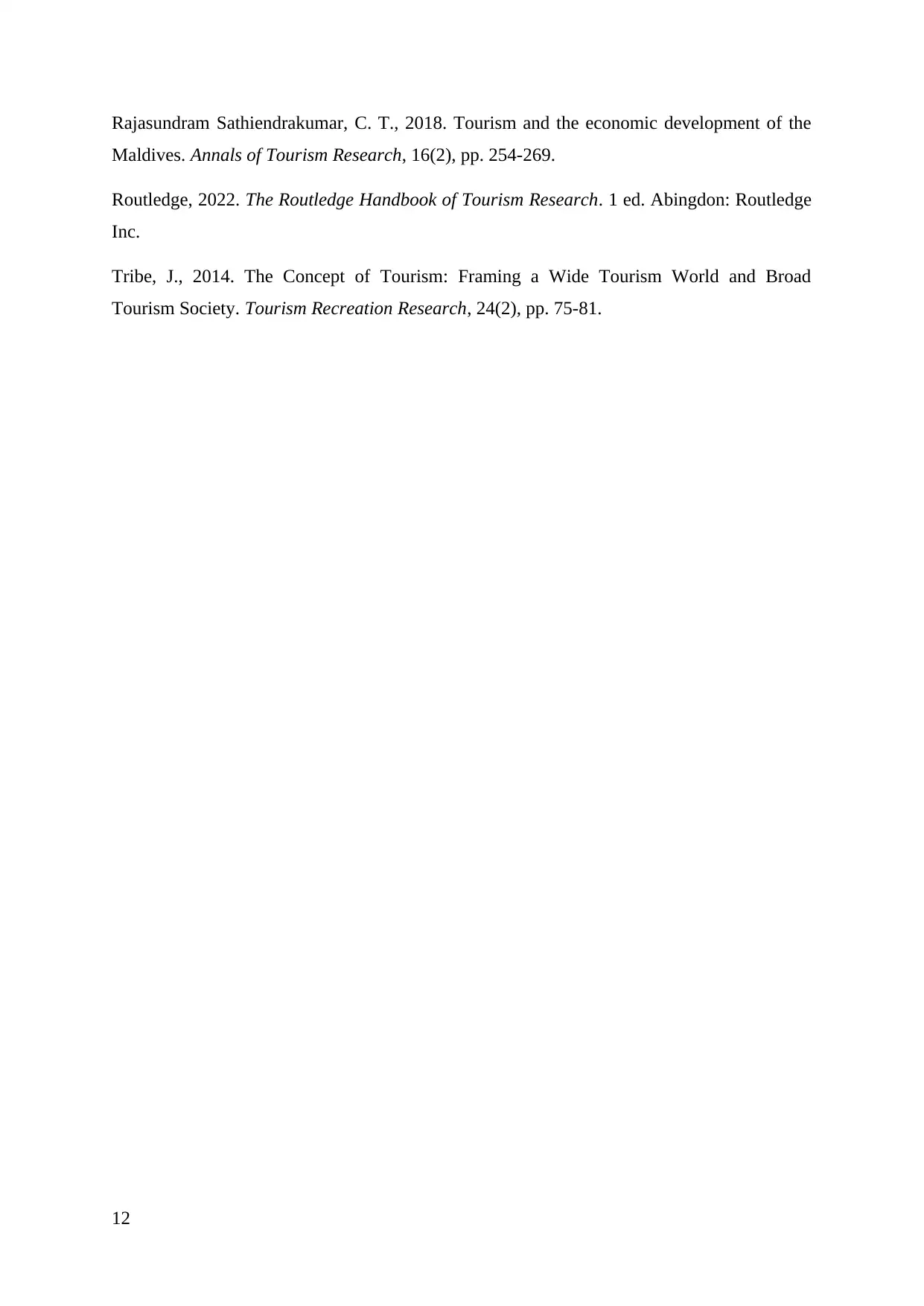
Rajasundram Sathiendrakumar, C. T., 2018. Tourism and the economic development of the
Maldives. Annals of Tourism Research, 16(2), pp. 254-269.
Routledge, 2022. The Routledge Handbook of Tourism Research. 1 ed. Abingdon: Routledge
Inc.
Tribe, J., 2014. The Concept of Tourism: Framing a Wide Tourism World and Broad
Tourism Society. Tourism Recreation Research, 24(2), pp. 75-81.
12
Maldives. Annals of Tourism Research, 16(2), pp. 254-269.
Routledge, 2022. The Routledge Handbook of Tourism Research. 1 ed. Abingdon: Routledge
Inc.
Tribe, J., 2014. The Concept of Tourism: Framing a Wide Tourism World and Broad
Tourism Society. Tourism Recreation Research, 24(2), pp. 75-81.
12
⊘ This is a preview!⊘
Do you want full access?
Subscribe today to unlock all pages.

Trusted by 1+ million students worldwide
1 out of 12
Related Documents
Your All-in-One AI-Powered Toolkit for Academic Success.
+13062052269
info@desklib.com
Available 24*7 on WhatsApp / Email
![[object Object]](/_next/static/media/star-bottom.7253800d.svg)
Unlock your academic potential
Copyright © 2020–2025 A2Z Services. All Rights Reserved. Developed and managed by ZUCOL.



